| Start of section
Production, amateur Radio amateurs Aircraft model, rocket-model Useful, entertaining |
Stealth Master
Electronics Physics Technologies Inventions |
Secrets of the cosmos
Secrets of the Earth Secrets of the Ocean Tricks Map of section |
|
| Use of the site materials is allowed subject to the link (for websites - hyperlinks) | |||
Navigation: => |
Home / Technology market / Current inventions and models / Back / |
|
INVENTION
Patent of the Russian Federation RU2285136
INTERNAL COMBUSTION ENGINE STASHEVSKY I.I.
![]()
Name of applicant: Stashevsky Ivan Ivanovich (RU)
The name of the inventor: Stashevsky Ivan Ivanovich (RU)
The name of the patent holder: Stashevsky Ivan Ivanovich (RU)
Address for correspondence: 352243, Krasnodar Territory, Novokubansk 3, ul. Leningrad, 19, apt.116, to I.Stashevsky
Date of commencement of the patent: 2004.12.14
The invention relates to engine building, in particular to internal combustion engines operating on hydrogen. The invention makes it possible to simplify the design, reduce weight and reduce the size of the engine, increase power. The internal combustion engine contains power supply systems, ignition systems, lubricants, a capacitor, a container with a battery in it containing electrodes, a pump, a vacuum cylinder equipped with a vacuum regulator, vacuum pumps. The engine consists of a cast cylinder with longitudinal channels parallel to each other along the perimeter of the cylinder and connected in series with each other by means of U-shaped channels located in the molded end caps through the gaskets of screw connections. Inside the cylinder there are rotating rotor blades rigidly fixed to the shaft by means of a drum, the blades divide the cylinder into four chambers. Each chamber in the cross section is made in the form of a triangle, the chambers are designed to work in a four-cycle cycle: suction, compression, expansion and exhaust of water vapor; Transformation of hydrogen and oxygen into the heat of the working fluid, transformation of the heat of the working fluid into mechanical energy; Transfer of steam to the turbine by means of a pump. The suction chamber of the cylinder is connected to the capacity of an electrolytic cell or a device for splitting water through gas pipelines. In the cylinder there is a microswitch connected to the spark plugs through the ignition coil by means of an electric circuit powered by a battery or generator. The lubrication system is equipped with an oil tank connected to an oil pipe, an oil seal, a hollow shaft, radial channels. The engine and turbine are connected to electric generators with the possibility of converting mechanical energy into electrical energy.
DESCRIPTION OF THE INVENTION
The invention relates to the automotive industry and can be used on tractors, river and sea vessels, motor ships, tractors and other machines.
An internal combustion engine is known, comprising a crank mechanism, a gas distribution mechanism, power, ignition, lubrication, cooling systems; A condenser, an electrolytic cell, an exhaust pipe connected to the condenser by a pump, an electrolyzer tank equipped with a battery. The battery contains plate, perforated, corrugated, brush-shaped, cell, cell honeycomb, cell scalloped or tubular electrodes. The electrodes are rigidly connected to each other through dielectric washers using bolts and nuts, the electrodes are installed in parallel, between them there is a gap and a different polarity. The electrolyzer is equipped with an accumulation chamber, vacuum pumps with a vacuum regulator (see RF patent No. 2188328, published on August 27, 2002) .
The Wankel internal combustion engine is known, comprising a rotor, a shaft, water cooling, a cylinder, spark plugs. The rotor rotates inside the cylinder along a special curve (epitrochoid). The rotor shaft is rigidly connected to the gear wheel, which engages the movable gear. A rotor with a gear wheel rolls around the pinion, its faces slip along the guides of the cylinder. The mass and dimensions of the engine are 2-3 times less than the engines corresponding to them in terms of power of another design (Polytechnic Dictionary, M. 1976, p. 69) .
The aim of the invention is to simplify the design, reduce the weight and size of the engine, increase power and expand technological capabilities, increase productivity when splitting water into hydrogen and oxygen.
The goal is achieved in an internal combustion engine containing power, ignition, lubrication, capacitor, capacitance, with a battery containing electrodes, a pump, a vacuum cylinder equipped with a vacuum regulator, vacuum pumps. According to the invention, the engine consists of a cast cylinder with longitudinal channels parallel to each other along the perimeter of the cylinder and connected in series with each other by means of U-shaped channels located in the molded end caps through the gaskets of the screw connections; inside the cylinder there are rotating rotor blades, Rigidly fixed to the shaft by means of a drum, the blades divide the cylinder into four chambers, each chamber in the cross section is in the form of a triangle, the chambers are configured to work in a four-cycle cycle: suction, compression, expansion and exhaust of water vapor; Transformation of hydrogen and oxygen into the heat of the working fluid, transformation of the heat of the working fluid into mechanical energy; Moving the steam to the turbine by means of a pump, the suction chamber of the cylinder is connected to the capacity of the cell or device for splitting water through the gas lines, a microswitch is placed in the cylinder connected to the spark plugs through the ignition coil by means of an electric circuit powered by a battery or generator; the lubrication system is equipped with an oil tank , Connected to an oil pipeline, an oil seal, a hollow shaft, radial channels, the engine and the turbine are connected to electric generators with the possibility of converting mechanical energy into electrical energy.
Even electrodes can be connected between themselves and with an alternating current source by means of an electrical converter adapted to convert an alternating current into a direct current, unipolar odd electrodes are connected to each other and to an alternating current source via an electric machine converter and an electric pulse generator, the electric machine converter being made With the possibility of converting an alternating current into a direct current, a low-voltage current into a high-voltage current, the electric-impulse generator is configured to generate electrical pulses, adjust the pulse frequency and the duration of the pulses in resonance mode in accordance with the resonance frequency of the water molecules.
Electrodes can be made plate, or corrugated, or perforated, or celled, or brush-shaped, or cell honeycomb, or cell scallop, or tubular.
Due to the device for splitting water, productivity is increased.
Due to the use of the engine, the mass and dimensions of the engine are reduced by 2-3 times, the engine power is increased.
Due to periodic explosions, instead of burning in the engine chamber, steam is released and a large amount of energy is released in a limited volume over a short period of time with very high pressure.
Due to the use of different variants of the combustion chambers of the engine, an expansion of technological capabilities is provided.
Due to the rotating rotor with cavities placed inside the cylinder, a four-cycle cycle is performed without the use of a special gas distribution mechanism.
Due to electric generators connected to the motor rotor and turbine by means of shafts, mechanical energy is converted into electric energy.
By connecting the exhaust chamber to the turbine by means of a pump, accelerated removal of gases from the exhaust chamber, stabilization of gas pressure, and increase in turbine productivity are provided.
Due to the longitudinal channels located along the perimeter of the engine cylinder, heat is removed from the walls of the engine cylinder by circulating water by means of a pump and steam is produced at the outlet.
Due to the use of liquid level regulators in a vacuum cylinder and deaerator, maintenance of the liquid level within specified limits is ensured.
By connecting the oil tank to the ends of the rotor blades through the oil line, the stuffing box, the hollow shaft, the oil channels, the valve, automatic lubrication of the friction surfaces of the blades and cylinder with lubricant is provided as necessary.
When examining the claimed technical solution for patent, scientific and scientific-technical materials, such a set of characteristics was not found, which allows to judge the materiality of the declared characteristics.
The essence of the invention is explained by the drawings:

1 is a general diagram of an engine arrangement
 FIG. 2 shows the connection of the water channels of the cylinder and its covers |
 3 is a cross-sectional view of the engine, the first embodiment |
 4 is the same as the second embodiment |
 5 shows the same, the third variant |
 6 shows the same, the fourth variant |
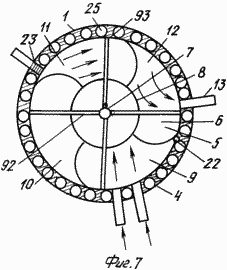 FIG. 7 shows the same, fifth and sixth variants |
 8 is the same, the seventh embodiment |
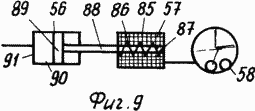 9 shows a dispenser and a solenoid device |
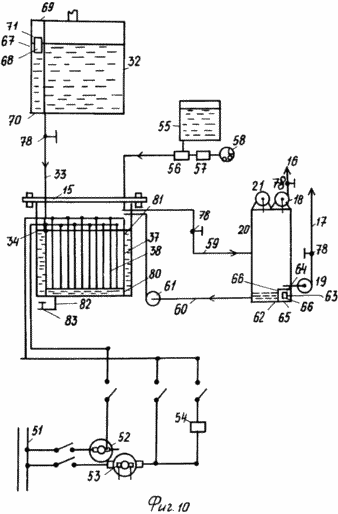 10 shows a diagram of a device |
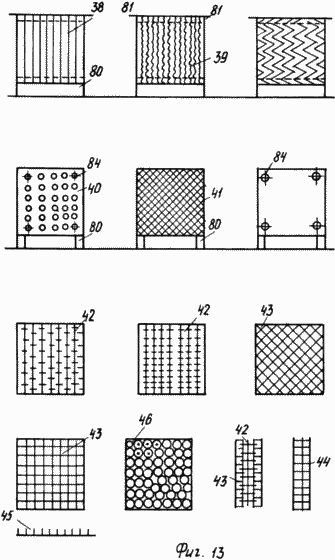 13 shows electrode variants |
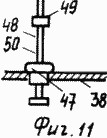 11 shows a circuit for connecting the electrodes to a battery |
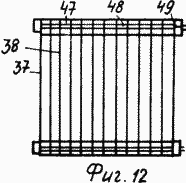 12 shows a battery |
The invention includes an engine 1, a reactive steam turbine 2, an electric generator 3. The engine 1 consists of a cast cylinder 4 made on pressure casting machines, a rotor 5 with blades 6 rigidly fixed to the hollow shaft 7 by means of drums 8. Blades 6 separate the container Cylinder 4 to equal four chambers 9, 10, 11, 12, feeding chamber 9, compression chamber 10, expansion chamber 11, exhaust gas chamber 12. The chambers 9-12 in the cross-section are made in the form of a triangle, designed to dispense the hydrogen and oxygen gas by means of the cavities 6 of the rotor 5, converting the hydrogen and oxygen fuel (combustion gas) into the heat of the working fluid (into water vapor) by periodic low-power explosions Explosive gas accompanied by the release of a large amount of energy in a limited volume in a short time with high pressure, transforming the heat of the working fluid into mechanical energy. The chamber 12 is connected to the reactive steam turbine 2 by means of a steam line 13 and a centrifugal electric pump 14 designed to accelerate the removal of water vapor from the chamber 12 into the steam turbine 2, stabilize the gas pressure, increase power and efficiency. The capacity of 15 may be the capacity of a device for splitting water or the capacity of an electrolytic cell.
The feed chamber 9 of the engine 1 is connected to the vessel 15 of a device for splitting water through the pipes, hydrogen 16 and oxygen 17 gas lines, vacuum pumps 18 and 19, a vacuum cylinder 20. The vacuum cylinder 20 is provided with a vacuum regulator 21. On the upper side surface of the cylinder 4, a spring-loaded microswitch 22 is disposed. The micro switch 22 is connected to the spark plugs 23 through the ignition coil 24 by an electric circuit capable of igniting the explosive gas in the chamber from a high voltage spark when the blade 6 is moved to a predetermined point. The walls of the cylinder 4 are provided with longitudinal channels 25 located along the perimeter of the cylinder, parallel to each other at equal distances from each other. The channels 25 are connected in series by means of semicircular channels 26 located in the molded end caps 27. The cylinder 4 is connected to the covers 27 through the gaskets 28 by screw connections 29. By means of the electric pump 30, cold water is supplied to the channels 25, the cylinder 4 , Removal of heat, generation of steam at the outlet, and movement of steam to the turbine 2. The turbine 2 is connected to the water jacket channels 25 via an electric pump 30, the capacitance of the condenser 31, the deaerator 32. The deaerator 32 is connected to the water splitting device 15 by a tube 33. The tube 33 is provided with a check valve 34.
Each camera can be made in the second variant. The second variant is the same as the first variant, differs from it in that each chamber has a triangular shape in the cross section, where the outer side of the chamber describes the shape of the arc of the cylinder, the inner side is rectilinear, has rounded corners at the ends of the triangle. The height of the camera triangle is in the form of an arc. All paired rotor blades 6 are curved in one direction.
Each camera can be made in the third variant. The third variant (Fig. 4) is the same as the second variant, differs from it in that one side of the blade 6 of the rotor 5 is rectilinear, the other two sides are curved in the form of an arc.
Each camera can be made in the fourth variant. The fourth variant (FIG. 5) is the same as the 1-3 variants, differs from them in that all sides of the blades 6 are paired and bent to one side. Each chamber in the cross section has the form of a triangle. The outer side of the chamber describes the shape of the arc of the cylinder 4, the inner side is in the form of a curved line. The height of the triangle is in the form of an arc.
Each camera can be made in the fifth version. The fifth variant (FIG. 6) is the same as the variants 1-4, differs from them in that the curved blades 6 of the rotor 5 are rigidly fixed on the drum 8.
Each camera can be made in the sixth variant. The sixth variant (Fig. 7) is the same as the fifth variant, differs from it in that the truncated, semicircular paired blades 6 with the radial chamber side closed are rigidly fixed on the drum 8 of the rotor 5, where the outer side of the chamber describes the shape of the arc of the cylinder. The inside of the chamber has a curved broken line. The height of the triangle is straight.
Each camera can be made in the seventh version. The seventh variant is the same as the sixth variant, differs from it in that the height of the triangle has the form of an arc.
Each camera can be made in the eighth version. The eighth variant (FIG. 8) differs from the 1-7 embodiment in that spring-loaded shoes 35 are rigidly fixed at the ends of the blades 6 of the rotor 5 by means of flat leaf springs 36.
A removable, interchangeable battery 37 is disposed in the water splitter vessel 15. The battery 37 consists of a plate 38, either corrugated 39, or perforated 40, or mesh 41, or brush-shaped 42, or cell 43, or cell honeycomb 44, or cell scallop 45 , Or tubular 46 electrodes made of stainless steel made on injection molding machines. Electrodes can be used in combined versions. Between the cell electrodes 43 or 44, 45, brush-shaped electrodes may be mounted interconnected through dielectric washers 47 by means of bolts 48 and nuts 49 and split spring washers 50. The electrodes are parallel to each other, there is a gap between them and one polarity. The needles of the brush-shaped electrodes 42 are installed at the center of each cell of the cell electrodes, there is a proper gap and one polarity between the cell walls and the needles. The even electrodes are connected to each other and to an alternating current source 51 by means of an electrical converter 52. They are adapted to convert an alternating current into a direct current and convert the electric current parameters into a weak electric current of 10 -3 A. Odd electrodes, unipolar, are connected to each other and to a variable source Current through the electric machine converter 53 and the electric pulse generator 54. The electric machine converter 53 is configured to convert an alternating current into a direct current, a low-voltage current into a high-voltage current. The electric impulse generator is configured to generate electric pulses and with the possibility of adjusting the voltage, the pulse frequency, the duration of the action of the pulses in the resonance mode, in order to match the resonance frequency of the water molecules, to charge the water with the same polarity. The container 15 is connected to a container 55 with a liquid alkali (caustic sodium or potassium hydroxide) through a dispenser 56. The dispenser 56 is provided with a solenoid 57 and a time relay 58 configured to control the dispensing of liquid alkali over a period of time. The water splitting vessel 15 is connected to the vacuum cylinder 20 by a gas conduit 59 and a water pipe 60 via an electric pump 61. The vacuum cylinder 20 is connected to the engine room 9 of the engine 1 via the hydrogen 16 and oxygen 17 gas lines and vacuum pumps 18 and 19 made with The possibility of extracting hydrogen and oxygen during the splitting of water in the vessel 15, separating hydrogen and oxygen in a vacuum due to the difference in the specific gravity of the gases, and the movement of hydrogen through the gas line 16, and oxygen through the gas line 17 into the engine chamber 1. In the vacuum tank 20 is located A liquid level regulator made of a float chamber 62 and a float 63. In the upper and lower base of the float 63, permanent magnet plates 66 interacting with reed switches 64 and 65 are arranged. The reed switch 64 operates to close the electrical circuit supplying the electric pump 61 and the reed switches 65 operate To open the electrical circuit 61. The deaerator 32 is designed to remove gases from the water. The deaerator 32 is provided with a liquid level regulator consisting of a float chamber 67 of a float 68. In the upper and lower base of the float chamber 67, reed switches 69 and 70 are arranged. The reed switch 69 operates to close the electrical circuit. The reed switch 70 operates to open the electrical circuit of the electric pump 30. On the float 68, permanent magnet plates 71 are disposed in the upper and lower base. The condenser vessel 31 is connected to the deaerator vessel 32 by a siphon 72. The condenser coil 73 in the upper and lower base is connected to the radiator battery 74 by a water pipe 71 and an electric pump 76. The radiator battery 74 is provided with an electric fan 77. The gas pipelines 16 and 17 are arranged Valves 78. Deaerator 32 is connected to the water jacket with water channels 25 by means of a water conduit 79. Battery 37 comprises legs 80 and side spacers 81 made of dielectric material. In the vessel 15, a downcomer 82 with a tap 83 is located at the bottom.
The device works as follows. The electric circuit feeding the unipolar electrodes 38 or 39-46, the vacuum pumps 18 and 19, the time switch 58, the electric pumps 14 and 76 and the electric fan 77 are closed. The electric current passing through the electric converter 52 converts the alternating electric current into a constant Current transforms the parameters of the electric current into a weak electric current of 10 -3 A. The electric motor converter 53 converts the alternating electric current into a constant electric current, the low-voltage current into a high-voltage current. The electric pulse generator converts the electric current into electrical pulses. We make adjustments to the voltage, the pulse frequency, the duration of the pulses in the resonance mode, by adjusting the adjustment according to the resonance frequency of the water molecules. Water molecules are charged with one polarity, hydrogen and oxygen are released. In this case, a high pulse frequency leads to the formation of a stepwise raising potential on the electrodes until it reaches the point of decomposition of the water molecules and a short-time current pulse arises. There is a race. This jump locks the impulse for several cycles, allowing the water to recover. In this case, hydrogen and oxygen are released. Then all operations are repeated. Vacuum pumps 18 and 19 create a low pressure in the vacuum cylinder 20 and the container 15. As a result of the vacuum in the vessel 15, hydrogen and oxygen are extracted during the water splitting in the vacuum tank 20, hydrogen and oxygen are separated from the difference in the whole weight of the gases, hydrogen Moves upwards and by means of the vacuum pump 18 it moves to the chamber 9 of the engine 1. The oxygen moves downwards and by means of the vacuum pump 19 from the vacuum cylinder 20 moves to the chamber 9 of the engine 1.
The device for splitting water can be made in the second variant - in the form of an electrolytic cell with a capacity of 15. Anodes are located between the cathodes. The anodes are connected to each other and to an alternating current source via an electric machine converter 53. The electric machine converter 53 is configured to convert an alternating current into a direct current. The cell capacity 15 contains a battery 37 with electrodes 38-45 disposed parallel to each other, there is a proper gap and a different polarity between them. The cell capacity 15 is filled with electrolyte (distilled water with the addition of a small portion of liquid alkali). The cathode is followed by a reduction reaction, and an oxidation reaction at the anode. The cell capacity 15 is hermetically sealed and designed for continuous operation and is made of stainless steel or other materials resistant to electrolyte and has a rectangular shape. The electrodes can be plate-like 38, or corrugated 39, perforated 40, reticulated 41, brush-shaped 42, cell 43, cellular honeycomb 44, cellular scallop 45, tubular 46 of stainless steel. The electrodes 38 or 39-45 at the corners have openings 84, through which the same electrodes are rigidly connected to the battery 37 through the washers 47 by means of bolts 48, nuts 49 and split spring washers 50. There is a proper gap and a different polarity between the electrodes. The battery 37 may contain combined electrodes: cell 43, or cellular honeycombs 44, cell scallop electrodes 45, brush-shaped electrodes 42 located between them, where the needles of brush-shaped electrodes on both sides are positioned at the center of each cell. Between the needles of brush-shaped electrodes and the walls of the cells there is a proper gap and a different polarity. The solenoid 57 consists of an inductor 85, a core 86, springs 87. The core 86 is rigidly connected to the stem 88. The stem 88 is connected to the piston 89. The piston 89 is disposed in the cylinder 90. A micro-switch 91 is disposed on the wall of the cylinder 90. The ends of the blades 6 of the rotor 5 are connected With a hollow shaft 7, which combines the function of the main oil distribution pipeline. The shaft 7 is connected to the radial channels 92, the valves 93 are located at their ends. The hollow shaft 7 is connected to the oil tank 94 by means of an oil pipe 95 and an oil seal 96. The oil tank is located above the level of the engine 1. The ignition coil 24 is connected to the battery 97 by an electric circuit .
The splitting of water into hydrogen and oxygen can be carried out in the second variant - in an electrolyzer. The second variant is the same as the first variant, differs from it in that water splitting is carried out by electrolysis of water in the tank 15, where a battery 37 with electrodes 38 or 39-46 is located. The anodes are located between the cathodes. The anodes are connected to each other and an alternating current source via the electric machine converter 53. The electric machine converter 53 converts the alternating current into direct current. The external voltage of the electric current must be sufficient. On the surface of electrodes 38 or 39-46 electrochemical reactions are cathodic and anodic. The electric current in the electrolyte is the process of ion movement to the cathodes. Cations - positive charged hydrogen ions move to the cathodes, anions - oxygen ions move to the anode. The electric current in the external circuit represents the process of movement of the electrodes from the anode to the cathode. At the cathode and at the anode, ion neutralization reactions occur that lead to the formation of atoms and molecules and the release of hydrogen and oxygen from the electrolyte. The most important factor affecting the nature and speed of electrochemical reactions is the magnitude of electrode potentials at which electrolysis of water proceeds. The difference in the potentials of the discharge of the anion and the cation that form part of the electrolyte is called the intensity of the given electrolyte. To increase cathodic reactions, the cathode potential is changed toward a negative value, and to increase the rate of anode reactions, the anode potential is changed toward a positive value. The vacuum regulator 21 automatically maintains in the specified low pressure settings. Hydrogen and oxygen are transferred to the chamber 9 of the engine 1 via the gas lines 16 and 17 through the valve 78.
Chamber 9 is filled with hydrogen and oxygen, the gas is mixed and a rattling gas is formed. The electric pump 14 moves the air from the chamber 12. In different chambers, a different pressure is created in the cylinder 4, which causes the blades 6 of the rotor 5 to rotate. As soon as the detonating gas moves to the chamber 11, the vane 6 switches on with the microswitch 22, it closes the electric circuit supplying The ignition coil 24, it will create a high voltage in the spark plug 23, from the spark of which the explosive gas (hydrogen and oxygen) will ignite, at the moment of the displacement of the blades. 6. There is an explosion, as a result, a large amount of energy is released in a limited volume in a short time, Is converted into water vapor with high pressure. The pressure in the chamber will be uneven, the pressure in the sharp corner of the chamber will be minimal, the pressure on the sides will be large, but there the walls are very strong. The height of the triangular chamber is a movable side, therefore all the pressure in the chamber will be directed only forward and the gases, pushing away from the inclined sides of the triangular chamber, move the blades 6 of the rotor 5 about the axis clockwise. Water vapor with high pressure and high temperature moves from the chamber 12 through the steam line 13 to the reactive steam turbine 2. With the help of an electric centrifugal vane pump the steam moves to the turbine 2, the chamber 12 is completely freed from gases, the power and efficiency increase and the pressure stabilization Gases. Hydrogen and oxygen are continuously transferred from the vessel 15 through the gas lines 16 and 17. In the chamber 9, hydrogen is mixed with oxygen to form a detonating gas. Blades 6 dispense a portion of gas and move gas from chamber 9 to chamber 11 through chamber 10. Once the gas has moved to chamber 11, blade 6 will turn on microswitch 22 which closes the electrical circuit feeding the ignition coil 24. This creates a high voltage In the spark plug 23 ignition with an electric spark ignites the explosive gas, an explosion occurs. Then all operations are repeated. In this case, the blades 6 move, moving the gas from one place to another, performing a four-cycle cycle. The chamber 9 receives a portion of hydrogen and oxygen, chamber 10 compresses, chamber 11 ignites and expands the gas, chamber 12 produces exhaust gases. Electric pump 14 removing exhaust gases - water vapor accelerates the rotation of the cavities 6 of the rotor 5. With hydrogen and oxygen, a small part of the water vapor enters the vacuum cylinder 20. The water vapor condenses on the walls of the vacuum cylinder 20 and drips onto the bottom of the vacuum cylinder 20, accumulates. As soon as the liquid level rises to the level of the reed switch, 64 the float 63 floats in the float chamber 62. The permanent magnet 66 of the float 63 interacts with the reed switch 64. The reed switch 64 closes the electric circuit supplying the electric pump 61. The pump 61 moves the condensate from the vacuum cylinder 20 to the vessel 15 to the home position. As soon as the condensate level moves to the bottom of the vacuum cylinder, the float 63 with the permanent magnet 66 contacts the reed switch 65. The reed switch 65 opens the electric circuit supplying the electric pump 61. The operation of the pump 61 stops. For a certain period of time, the time relay 58 triggers and opens the electric circuit feeding the solenoid 57. A magnetic field disappears in the solenoid 57. Under the action of the spring 87 and the core 86, they move beyond the solenoid 57, moving the rod 88 of the piston 89 of the dispenser 56. The dispenser 56 doses a portion of the liquid alkali. Once the piston 89 has moved to the end of the cylinder 90, it contacts the microswitch 91. The micro switch 91 opens the electric circuit supplying the solenoid 57 and the relay times 58. The inductor 85 creates a magnetic field. Under the influence of the magnetic field, the core 96 is drawn into the solenoid 57, compressing the spring 86. The core 86 moves the rod 88. The rod 88 moves the piston 89 in the cylinder 90 to its original position. Then all operations are repeated. When the blades 6 rotate 5 from the oil tank 94, the lubricating material is moved by gravity to the friction surfaces of the cylinder 4 and the blades 6 of the rotor 5 as needed. In the capacitance of the condenser 31, gaseous water vapor condenses to a liquid state. With the help of the electric pump 76, the coil 73, the radiator battery 74 and the fan 77, water is cooled. The heat removal is performed by the circulating coolant from the condenser 31 to the radiator battery by means of an electric pump 76 and the heat dissipation of the radiator battery 74 by the airflow by the electric fan 77. Once the condensate is filled above the level of the siphon 72, the siphon 72 triggers and moves the condensate by gravity from the capacitor 31 Into the capacity of the deaerator 32. From the deaerator 32 gases are vented to the atmosphere and accumulation of condensate takes place. As soon as the level of the condensate rises to the upper level in the float chamber 67, the float 68 floats up. The permanent magnet 71 of the float 68 interacts with the city committee 69. The reed switch 69 closes the electric circuit supplying the electric pump 30. The electric pump 30 moves the condensate 32 to the water jacket channels 25 of the engine 1. As soon as the condensate level moves to the bottom of the vessel 32, the float 68 will move to the bottom of the float chamber 68, while the permanent magnet 71 contacts the reed switch 70. The reed switch 70 opens the electric circuit supplying the electric pump 30. The pump 30 stops operating. Then all operations are repeated. Distilled water is transferred from the deaerator vessel 32 to the vessel 15 by gravity as needed. The check valve 34 maintains a predetermined liquid level in the container 15.
CLAIM
1. An internal combustion engine comprising: power, ignition, lubrication, capacitor, capacitance with a battery therein comprising electrodes, a pump, a vacuum cylinder provided with a vacuum regulator, vacuum pumps, characterized in that the engine consists of a cast cylinder , In the walls of which there are longitudinal channels parallel to each other along the perimeter of the cylinder and connected in series with each other by means of U-shaped channels located in the molded end caps through the gaskets of screw connections, inside the cylinder rotor blades of the rotor fixed rigidly to the shaft by means of a drum , The blades divide the cylinder into four chambers, each chamber in the cross section is made in the form of a triangle, the chambers are designed to work in a four-cycle cycle: suction, compression, expansion and exhaust of water vapor; Transformation of hydrogen and oxygen into the heat of the working fluid, transformation of the heat of the working fluid into mechanical energy; Moving the steam to the turbine by means of a pump, the suction chamber of the cylinder is connected to the capacity of the cell or device for splitting water through the gas lines, a microswitch located in the cylinder is connected to the spark plug via an ignition coil by means of an electric circuit powered by a battery or generator; the lubrication system is equipped with an oil tank , Connected to an oil pipeline, an oil seal, a hollow shaft, radial channels, the engine and the turbine are connected to electric generators with the possibility of converting mechanical energy into electrical energy.
2. An engine of 1, characterized in that the even electrodes are interconnected by themselves and with an alternating current source by means of an electric converter adapted to convert an alternating current into a direct current, unipolar odd electrodes are connected to each other and to an alternating current source via an electric machine converter and Generator of electrical impulses, the electric machine converter being adapted to convert an alternating current into a direct current, a low-voltage current into a high-voltage current, the electric-impulse generator is configured to generate electrical pulses, adjust the pulse frequency and the duration of the pulses in resonance mode in accordance with the resonance frequency Molecules of water.
3. The engine of claim 1, wherein the electrodes are plate-like.
4. The engine of claim 1, wherein the electrodes are corrugated.
5. The engine of claim 1, wherein the electrodes are perforated.
6. The engine of claim 1, wherein the electrodes are made of cells.
7. The engine of claim 1, wherein the electrodes are brush-shaped.
8. The engine of claim 1, wherein the electrodes are made of cellular honeycombs.
9. The engine of claim 1, wherein the electrodes are made of cellular scallops.
10. The engine of claim 1, wherein the electrodes are tubular.
print version
Date of publication 28.12.2006гг




Comments
When commenting on, remember that the content and tone of your message can hurt the feelings of real people, show respect and tolerance to your interlocutors even if you do not share their opinion, your behavior in the conditions of freedom of expression and anonymity provided by the Internet, changes Not only virtual, but also the real world. All comments are hidden from the index, spam is controlled.